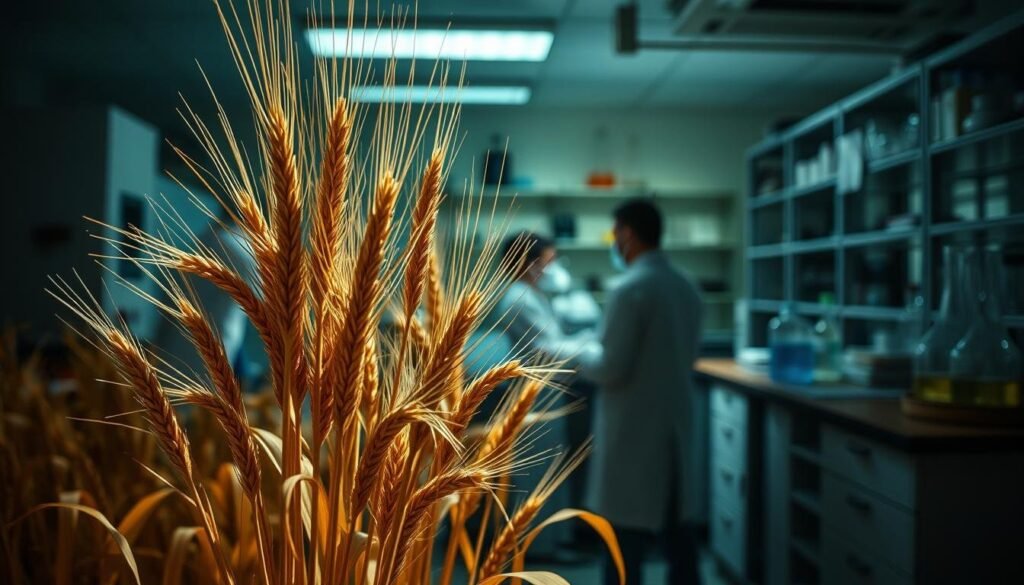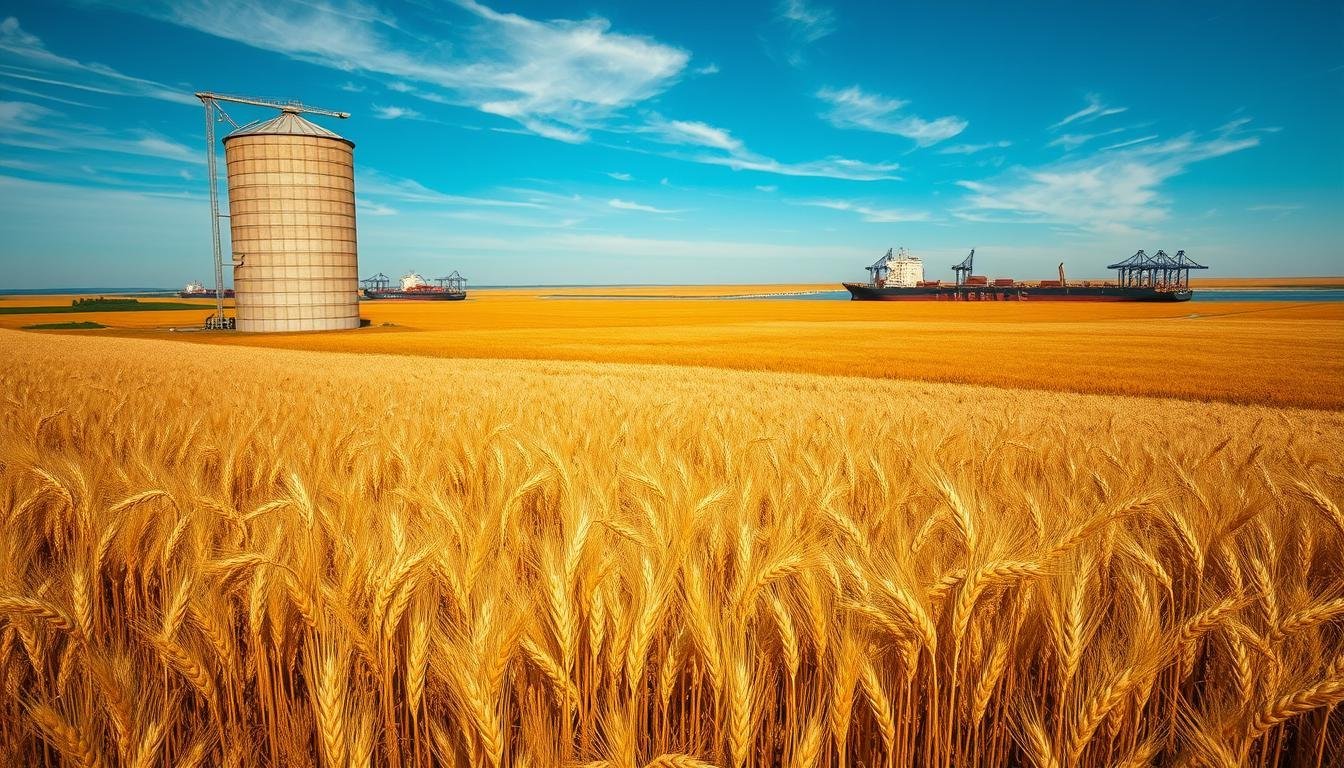You might be surprised to learn that US wheat exports face significant restrictions in Europe. This is due to strict food safety regulations.
The European Union has strict rules about genetically modified organisms (GMOs) and pesticide residues. These rules affect the import of US wheat. Because of this, US wheat exports to Europe have dropped a lot.
It’s important to understand why these restrictions exist. The difference in food safety rules between the US and Europe impacts trade and business a lot.
Contents
- 1 The Current Status of American Wheat in European Markets
- 2 Understanding Why Is American Wheat Banned in Europe
- 3 Agricultural Practices: US vs. Europe
- 4 The Glyphosate Controversy
- 5 GMO Regulations and Their Impact
- 6 Health and Safety Concerns for Consumers
- 7 Economic and Trade Implications
- 8 Conclusion
- 9 FAQ
- 9.1 Why is American wheat banned in Europe?
- 9.2 What is glyphosate, and why is it a concern?
- 9.3 How do GMO regulations in Europe impact American wheat imports?
- 9.4 What are the economic implications of the ban on American wheat?
- 9.5 How can consumers make informed choices about wheat products?
- 9.6 Are there any differences in wheat quality between the US and Europe?
- 9.7 Can American wheat be made compliant with European regulations?
The Current Status of American Wheat in European Markets
Have you wondered about American wheat’s status in European markets? The European Union has strict rules on wheat imports, especially about glyphosate residues.
Glyphosate is a common herbicide in American farming. European wheat regulations are stricter, allowing less glyphosate residue than in the US.
These rules are big for American wheat exporters. Here are some important points:
- The EU’s cautious approach to glyphosate means tighter limits in food products.
- American wheat, often treated with glyphosate, might not meet EU standards.
- US wheat exporters struggle to follow European rules.
It’s key to understand these rules for international wheat trade. Knowing these differences helps in trade agreements and US-Europe economic ties.
Understanding Why Is American Wheat Banned in Europe
Many wonder why American wheat is banned in Europe. It’s important to look at the history behind it. The controversy centers on genetically modified organisms (GMOs) and farming differences between the US and Europe.
Key Events Leading to the Ban
The problem started with GMO wheat in the US. Even though GMO wheat is not common, its presence in exports worried Europeans. A key moment was when GMO wheat was found in an Oregon field in 2013.
This event made Europeans more worried about American wheat’s safety and rules. Europe is strict about GMOs, unlike the US. This difference in rules has led to the ban on American wheat.
Another big issue is glyphosate, a herbicide used in American farming. Glyphosate on wheat fields, especially for “desiccation,” concerns health and the environment in Europe. So, European countries are careful about wheat imports that might have glyphosate.
To understand the ban on American wheat in Europe, it’s key to know the main events and concerns. This issue is not just about trade. It also involves big differences in farming and rules.
Agricultural Practices: US vs. Europe
Did you know the US and Europe have different ways of farming? These differences affect how wheat is grown and traded. Farming methods, rules, and how crops are managed vary greatly between the two.
In the US, farmers aim for high yields and use the latest technology. They often farm on a large scale. On the other hand, Europe focuses on farming that’s good for the environment. They have strict rules about using pesticides and herbicides.
Genetically modified organisms (GMOs) are another big difference. The US uses GMO wheat to improve yields and fight diseases. But Europe is more cautious about GMOs. Many European countries choose not to grow GMO crops at all.
Here’s a quick look at some key differences in farming between the US and Europe:
| Aspect | US | Europe |
|---|---|---|
| GMO Use | Widely adopted | Strictly regulated, many countries opt out |
| Pesticide Use | Less restrictive regulations | Stricter regulations, emphasis on organic practices |
| Farm Size | Large-scale farming common | Smaller, family-owned farms more prevalent |
These farming differences lead to debates and tensions in trade between the US and Europe. Knowing these differences helps us understand the global wheat market better.
The Glyphosate Controversy
When looking into why American wheat is banned in Europe, the glyphosate debate is key. Glyphosate is a common herbicide in the US, but it’s linked to health problems. This has started a big argument about its use in farming.
In the US, glyphosate is used to grow wheat. It helps control weeds and increase crop size. But, its presence on wheat worries Europeans, who fear health risks.
Research shows glyphosate might increase cancer risks and other health issues. This has made European officials very careful about glyphosate. They’re making stricter rules about its use.
The glyphosate debate is not just about health. It also involves how we farm and use chemicals. As people learn more about their food, they want products without glyphosate.
Some American farmers are now looking for new ways to manage weeds and crops. This could mean big changes in how we farm.
GMO Regulations and Their Impact
Did you know GMO rules affect wheat trade between the US and Europe? The European Union has strict rules on genetically modified organisms (GMOs). This greatly impacts American wheat exports.
GMOs are living things whose genes have been changed by humans. In the US, GMO rules are less strict than in the EU. The EU’s approval process for GMOs is very careful, leading to a slow adoption of GMO crops.
The strict GMO rules in Europe affect wheat trade. For example, some American wheat is made to fight pests or diseases. But, these types might not be allowed in the EU because of its strict GMO policies.
- The EU’s cautious approach to GMOs means stricter rules.
- American wheat sent to Europe might have GMOs not okayed in the EU.
- European markets prefer non-GMO wheat, which limits US exports.
Because of this, American wheat sellers must follow EU rules, which can be hard. The need to separate GMO and non-GMO wheat makes exporting more complicated and expensive. Knowing these rules is key for US exporters to keep their share of the European market.
Health and Safety Concerns for Consumers
It’s important to know how American wheat affects our health. As a buyer, you want to make sure your food is safe and of good quality. The debate over American wheat, including glyphosate use and GMOs, has raised many health concerns.

Some U.S. farming practices differ from those in Europe. Europe has stricter rules on glyphosate and GMOs. This affects the quality and safety of wheat. Knowing this helps you make better choices for your health.
To make smart choices, consider these steps:
- Opt for non-GMO or organic products, as they have tighter controls on glyphosate and GMOs.
- Support local farmers who might follow stricter farming rules.
- Keep up with the latest research and rules on American wheat.
By following these steps, you can protect your health. It’s also crucial to push for clearer labels and stricter farming rules. Your choices and awareness can lead to changes in the industry.
Being an informed consumer is your first line of defense in ensuring your health and safety.
Economic and Trade Implications
The ban on American wheat has big effects on both the US and European economies. It has changed how trade works, with the US looking for new places to sell its wheat.
Expect more trade between the US and countries in Asia and Africa. This could make the US’s trade with these areas stronger. But, Europe will have to pay more for wheat or change how they grow it to meet their own rules.
The trade war implications are big, adding to the tension between the US and Europe over farm trade. This ban affects not just farms but also food processing and making.
It’s important to understand the big picture. The ban doesn’t just affect wheat but also has big effects on the world economy. It changes prices and trade balances. Keeping an eye on these changes is key for everyone involved.
In short, the ban on American wheat shows how complex global trade is. As we deal with these changes, it’s clear they affect many areas and policies around the world.
Conclusion
You now know why American wheat is banned in Europe. This ban is mainly because of different farming methods. The US uses glyphosate and GMOs more than Europe does. Europe has stricter rules for food safety.
The ban affects the US economy and trade a lot. It impacts not just farming but the whole economy. The US needs to change its farming ways to meet European standards.
Learning about the wheat ban helps us understand international trade and food safety better. European rules are made to keep consumers safe. The ban shows how the US and Europe differ in food production and safety.
FAQ
Why is American wheat banned in Europe?
American wheat is banned in Europe because of worries about farming methods. These include the use of glyphosate and genetically modified organisms (GMOs).
What is glyphosate, and why is it a concern?
Glyphosate is a weed killer used in American farming. Europeans worry about its health risks. They think it might cause cancer and other health problems.
How do GMO regulations in Europe impact American wheat imports?
Europe has strict GMO rules. Many American wheat types have GMOs. So, American wheat can’t meet European GMO standards, making it hard to sell there.
What are the economic implications of the ban on American wheat?
The ban on American wheat hurts both the US and Europe. American farmers lose export chances. Meanwhile, Europeans might see higher wheat prices and less supply.
How can consumers make informed choices about wheat products?
Consumers can choose wheat products labeled “GMO-free” or “organic.” These are more likely to meet European rules. They should also check where the wheat comes from and learn about the farm’s practices.
Are there any differences in wheat quality between the US and Europe?
Yes, wheat quality differs between the US and Europe. This is because of farming methods, climate, and soil. European wheat is often seen as better quality due to stricter rules and standards.
Can American wheat be made compliant with European regulations?
American wheat producers can follow European rules. They could stop using glyphosate and avoid GMOs. But, this would mean big changes to their farming. It could also raise their costs and make them less competitive.

Marcellus Stark is an investigative journalist from San Francisco, USA. He writes about global bans, rules, and unusual laws. He shares clear, interesting, and well-researched stories that help readers understand surprising facts worldwide.

